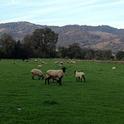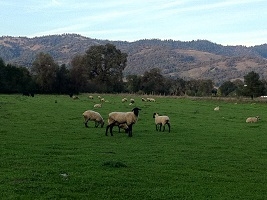- Author: John M Harper
The attached pdf, from Katie Delbar, provides initial info on assistance for ag producers with property in the recent Mendocino & Lake fires.
I've just begun to work on a smartphone app that I hope will make it easy to assess acreage damaged by the fires, economic value of the forage losses and reseeding requirements and cost assessments. I'll keep you posted on that progress.
Below are quite a few links for UC information on fire recovery that Ken Tate put together:
http://ucanr.edu/sites/postfire/
http://ucanr.edu/blogs/blogcore/postdetail.cfm?postnum=18117
http://ucanr.edu/sites/forestry/Wildfire/
http://ucanr.edu/News/Wildfire/
http://www.cafiresci.org/announcements-source/category/postfirerecoveryucanr
http://anrcatalog.ucanr.edu/pdf/8446.pdf
http://ucanr.edu/sites/forageloss/files/74150.xls
http://ucanr.edu/sites/forageloss/files/74149.xls
http://cesutter.ucanr.edu/Fire_Information/
http://ucanr.edu/?blogtag=wildfire&blogasset=60503
http://cecentralsierra.ucanr.edu/files/220420.pdf
http://anrcatalog.ucanr.edu/pdf/8386.pdf
http://ucanr.edu/blogs/blogcore/postdetail.cfm?postnum=19424
Redwood Complex Fire
- Author: John M Harper
This is a re-post from CWGA.
CWGA Legislative Action Alert – Members located in Marin County and Surrounding Areas:
Marin County is in the process of correcting an omission in the land use code that for the last 15 years has left ranchers in Marin without a pathway to commercial livestock slaughter in the county. On March 14th, the Board of Supervisors will meet to consider changes to the development code that would allow ranchers to conduct small-scale on-farm slaughter of poultry as well as allow a mobile slaughter unit to provide small-scale USDA-licensed slaughter of all species on ranches in the county. Both of these proposed rules would make it possible for ranchers to bring product to market without traveling across the state, submitting animals to stressful travel and costing the farms time and money. Anyone who has an interest in Marin's ranching community and/or locally produced meat should plan to write letters to the Board of Supervisors and speak at the March 14th meeting. Letters can be sent to the Board of Supervisors at BOS@marincounty.org.
The proposed rules would specifically allow:
1. On-farm slaughter by a rancher of his/her own poultry (chickens, turkeys, ducks, geese) for commercial sale without a use permit. This would be limited to 20,000 chickens (or equivalent) per year and only in lands zoned A3 - A60 (lands zoned A2 or ARP as well as those located in the Coastal Zone would be excluded). Ranchers would be able to process animals that are raised "on the same site or on other agricultural properties located in Marin County that are owned or leased by the processing facility owner or operator” but rabbits (traditionally included in the definition of “poultry”) would be excluded from this rule. Additionally, these processing activities would be limited to 5000 square feet.
2. Mobile Slaughter Units (MSUs) could provide USDA-licensed slaughter services to ranchers for all species without a use permit on lands zoned A3 - A60 (lands zoned A2 or ARP as well as those located in the Coastal Zone would be excluded). MSU's could not operate on any single property for more than 3 consecutive days and up to 12 total days within a calendar month unless the rancher secures a temporary use permit. Ranchers from other properties could bring their animals to where an MSU is in operation to have their animals processed. The unit would have to be located more than 100 feet away from any property lines.
3. Stationary slaughterhouses providing USDA-licensed slaughter services for all species would NOT be allowed in Marin County.
On March 14th, the Board of Supervisors has the power to approve, deny or even change these recommendations up to and including:
• Re-inserting rabbits into number 1 above.
• Allowing numbers 1 and 2 above in lands zoned A2 or ARP (the Board cannot at this time change the land use rules for farms in the Coastal Zone).
• Reversing or modifying the recommendation in number 3 in order to allow for some form of brick-and-mortar USDA slaughterhouse.
Substantial pushback from those who oppose ranching and livestock slaughter is expected at the March 14th meeting. It is very important for the Board of Supervisors to hear from the agricultural community on this issue, and members of the public who value local meats produced on local lands should also speak. Potential talking points might include:
• Raising pastured livestock is one of the oldest and most appropriate uses of Marin's coastal grasslands
• Without access to local slaughter services, ranches incur great cost in money, time and fuel to truck animals out of the area …just so they can be sold back to Bay Area consumers.
• Slaughter services are an essential part of the ranching business. Raising animals in an ecologically sound fashion is a fruitless endeavor if those animals cannot affordably be brought to market.
• New and small-scale ranchers are particularly paralyzed by the costs and complexity of working with distant slaughter facilities.
Also being recommended by the Planning Commission is a new rule to require use permits for ranchers in lands zoned ARP if they want to conduct educational tours. Until now, these activities have been considered “principally permitted” (i.e. a by-right activity that requires no permit or permission from the county). In the development code, “educational tour” is defined as: "Interactive excursion for groups and organizations for the purpose of informing them of the unique aspects of a property, including agricultural operations and environmental resources.” This has historically included school visits, chef/buyer tours, tours by organizations such as MALT or AIM, as well as open-farm type programming to help connect with new CSA members and other customers. Lands zoned A3-A60 would be unaffected by this change, but for those in ARP lands, the requirement to secure a use permit could mean $5,000-10,000 and extensive review by county Planning before allowing one of these activities to take place on your land. Given the growing interest by the public in visiting farms and ranches as well as the importance of transparency in the food system, this may pose a problem for many ranchers. Making your voice heard on this issue is recommended as well.
Again, on both matters, letters should be sent to: BOS@marincounty.org and please plan to speak on Tuesday, 3/14 (time TBD) in Suite 330 of the Marin Civic Center.
For questions contact Vince Trotter, Agricultural Ombudsman for Marin County at 415-524-7394 or marinagombudsman@gmail.com.
- Author: John M Harper
The following is a re-post from ASI Weekly.
The How to Handle Sheep video series released by the American Sheep Industry Association, in collaboration with Temple Grandin, Ph.D., the Livestock Marketing Association and Colorado State University, is approaching 10,000 hits on YouTube. The three-part video details the process of handling sheep through the entire life span of the animal.
The training tool is available in English and Spanish. From producers and auction-facility workers to the transportation industry and harvesting personnel, everyone can follow Dr. Grandin as she discusses the best practices to use in handling sheep.
ASI Executive Director Peter Orwick strongly encourages all sheep operations to ensure their livestock workers, whether full- or part-time employees or neighbors, are educated.
"These videos are a convenient way to accomplish this goal," said Orwick. "Poorly trained or uneducated workers who help with sheep are a business liability that is not necessary with today's access to training."
The videos are available on ASI's YouTube Channel at www.youtube.com/user/SheepUSA1

- Author: John M Harper
The University of California Division of Agriculture and Natural Resources is seeking a Cooperative Extension Advisor who will serve UCCE Placer-Nevada and Sutter-Yuba Counties with headquarters in Auburn, CA. Please help spread the word about this position that will focus on integrating livestock, natural resources, food systems and economics.
A minimum of a master's degree is required, though other advanced degrees are encouraged, in disciplines such as animal science, rangeland management or other closely related fields. Incumbent is required to become a Certified Rangeland Manager within five years of date of hire; see http://casrm.rangelands.org/HTML/certified.html.
Excellent written, oral, and interpersonal communication skills are required. The ability to build partnerships and to work with multidisciplinary teams to address production and environmental challenges is required. Experience in applied research and extension is preferred.
SUBMIT BY date for full consideration is Monday February 27, 2017. It is position #AP16-20.
See the web link http://ucanr.edu/Jobs/Jobs_990/?jobnum=1123 for access to the full position announcement and required academic application form.
Questions about this recruitment may be directed to Karen Ellsworth: Phone: 530 750-1284; kaellsworth@ucanr.edu.
- Author: John M Harper
The following came from the NAMI Lean Trimmings newsletter.
Meat Institute to Launch MyMeatUp App Tuesday. The Meat Institute will nationally launch its new MyMeatUp app on Tuesday morning with a broad release to mainstream media outlets as well as college publications. The release is part of a larger marketing strategy for the app over the next several months. MyMeatUp is the first-of-its-kind mobile app aimed at helping consumers become more confident when buying meat and poultry. The free app is the only available app with a full guide to beef, pork, lamb and veal retail meat cuts, and draws on content from www.MyMeatUp.org, a popular resource that was launched in 2016.
Meat Institute staff and members have assisted in giving the app a solid rating prior to release. MyMeatUp currently has 29 five-star reviews in the Apple app store, which should help its searchability. Members who have not downloaded the app are strongly encouraged to do so and provide positive reviews. To download the iPhone version, click here. The Android version is available here.


